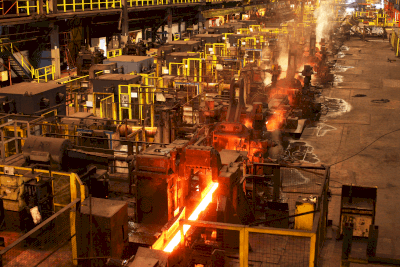What Is a Rolling Mill?

Rolling mills are used in steel mills to stretch steel.
Rolling is the process of stretching steel. The final thickness of the steel produced in a mill determines the number of rolling mills. Rolling mill stretches the steel by crushing it between motor-driven rolls, controlling the thickness (width) to a target value, which varies from product to product.
During rolling, it is important to stretch the iron that has been heated in the furnace before lowering the temperature.
Uses of Rolling Mills
Rolling mills are used to stretch steel. The main flow of rolling mills varies from mill to mill, but generally there are one to five roughing mills that roughly stretch the thick steel coming out of the furnace, followed by five to eight finishing mills that finish the steel to the actual thickness of the product.
Rolling mills can be broadly classified into roughing mills and finishing mills. Some roughing mills are equipped with a function called reverse rolling, in which the rolled steel is returned to the front of the rolling mill and rolled again in the same rolling mill. This method allows thick steel to be rolled to a certain degree of thinness.
Principle of Rolling Mills
The rolling mill stretches the steel between two rolls, which must be pressed down in order to stretch the steel. The pressing function is called “pressing down” and is driven electrically or hydraulically.
In order to control the thickness at the exit of each rolling mill, a position sensor or other device is attached to the screw or other parts of the roller if it is electrically driven. By linearly detecting the position, the amount of pressure drop is calculated to determine the material thickness.
In the case of hydraulic pressing, the material thickness is calculated by linearly monitoring the position of the cylinder inside the pressing equipment. Mainly, roughing mills often use only electric pressure reduction, while finishing rolling mills often use a combined electric and hydraulic pressure reduction system.
In finishing mills, the control method called automatic gap control (AGC) is also used, which is based on thickness feedback in combination with thickness gauges, such as X-rays and γ-rays, to eliminate errors from the target thickness. Therefore, AGC control is performed in combination with these factors as well.
Types of Rolling Mills
The following are the main types of rolling mills used in the rolling process.
1. 2-High Rolling Mill
Two-High Rolling Mill is the simplest type of rolling mill, with two rolls (working rolls) on the top and bottom, and is used for rough rolling of 20mm to 30mm and thin sheet rolling.
2. 4-High Rolling Mill
A 4-high rolling mill consists of two additional rolls (support rolls) added to the working rolls of a 2-high rolling mill. 4-high rolling mills do not use four rolls to roll metal, but rather sandwich the working rolls between the support rolls. The support rolls hold the deflection of the working rolls, enabling highly accurate processing.
3.Multi-Stage Rolling Mill
A multi-stage rolling mill is a rolling mill with more working rolls than a 4-stage rolling mill. Multi-stage rolling mills come in a variety of shapes and sizes, and each has many working rolls, enabling the processing of hard metals under high pressure. In addition, the shaft diameter of the rolls can be reduced for processing, making it possible to roll extremely thin materials such as silver foil.
Other Information on Rolling Mill
Types of Rolling Processes
Rolling mills are classified into three types: hot rolling, cold rolling, and warm rolling, depending on the temperature at which the rolling process is performed.
1. Hot Rolling
Hot rolling is a rolling process in which the metal is heated to 900°C to 1,200°C to soften it for easier processing. The metal is then passed through rolls and rolled.
The high temperatures result in a material with good workability and tenacity. However, the surface becomes whitish due to oxidation.
2. Cold Rolling
Cold rolling is a method of rolling at room temperature. The temperature is not heated as in hot rolling, but the heat generated in the metal rolling process raises the temperature somewhat.
The dimensional accuracy is higher than that of hot rolling, and the surface is shiny.
3. Warm Rolling P
The warm rolling process is an intermediate rolling method between hot rolling and cold rolling. It produces a finish that compensates for the disadvantages of hot rolling and cold rolling. It is often used in the production of aluminum foil.